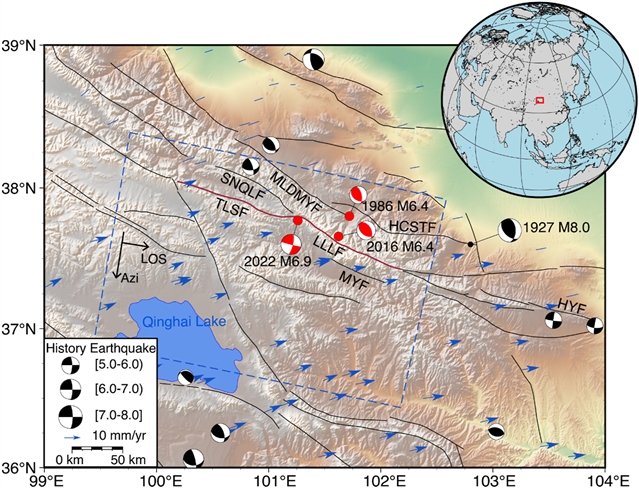
近日,中国地震局地震研究所赵斌团队研究了与2022年中国门源MW6.7级地震相关的浅层同震滑动及深部震后滑动。相关论文于2025年10月30日发表在《大地测量与地球动力学》杂志上。
研究同震破裂、震后余震及其相互作用的空间分布对于理解断层的非均质摩擦特征和地震危险性评估至关重要。
研究组对发生在青藏高原东北部天柱地震断裂带西端的2022年门源MW6.7级地震的地震和地震滑动进行了综合分析。通过整合近场GNSS测量、InSAR视距(LOS)位移和地表破裂数据,研究组通过运动学反演和机械约束模型改进了同震滑动分布。研究结果显示,在浅层深度(小于6公里)有一个出乎意料的大同震滑动,大约3.3米,同时还有最小的浅层滑动缺陷——这是在全球类似震级的地震中很少观察到的特征。
机械约束方法产生的静态应力降约为6.4 MPa。此外,研究组从主震后最初2.7年的累积GNSS位移记录中反演了余震分布。余震主要位于同震破裂带的下坡,释放了28.5%的同震力矩。余震的时空演化与下倾余震有密切的相关性,粘弹性松弛和孔弹性回弹的作用有限,表明余震机制主要控制震后早期变形。
附:英文原文
Title: Shallow coseismic slip and downdip afterslip associated with the 2022 MW6.7 Menyuan (China) earthquake
Author: Bin Zhao a
Issue&Volume: 2025/10/30
Abstract: Investigating the spatial distribution of coseismic rupture, postseismic afterslip, and their interactions is essential for understanding the heterogeneous frictional characteristics of faults, and seismic hazard assessments. This study offers a comprehensive analysis of both seismic and aseismic slip of the 2022 MW6.7 Menyuan earthquake, which took place at the western terminus of the Tianzhu seismic gap located in the northeastern Qinghai-Xizang Plateau. By integrating near-field GNSS measurements, InSAR line-of-sight (LOS) displacements, and surface rupture data, we refined the coseismic slip distribution using a kinematic inversion and a mechanically constrained model. Our results reveal an unexpectedly large coseismic slip of about 3.3 m at shallow depths (less than about 6 km), along with minimal shallow slip deficit—features rarely observed in earthquakes of similar magnitude globally. The mechanically constrained approach yields a static stress drop of about 6.4 MPa. Additionally, we invert for the afterslip distribution from cumulative postseismic GNSS displacements recorded during the initial 2.7 years subsequent to the mainshock. The afterslip is predominantly situated downdip of the coseismic rupture zone, releasing 28.5% of the coseismic moment. There is a tight correlation between the spatiotemporal evolution of aftershocks and the downdip afterslip, with limited contributions from viscoelastic relaxation and poroelastic rebound which indicates that the afterslip mechanism primarily controls early postseismic deformation.
DOI: 10.1016/j.geog.2025.08.002
Source: https://www.sciencedirect.com/science/article/pii/S1674984725000783
Geodesy and Geodynamics:《大地测量与地球动力学》,创刊于2010年。隶属于爱思唯尔出版集团,最新IF:2.4
官方网址:https://www.sciencedirect.com/journal/geodesy-and-geodynamics
投稿链接:https://www2.cloud.editorialmanager.com/geog/default2.aspx
